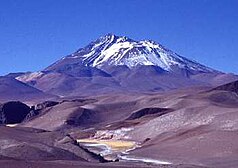Llullaillaco National Park
| Llullaillaco National Park | ||
|---|---|---|
| Llullaillaco | ||
|
|
||
| Location: | Antofagasta , Chile | |
| Next city: | Antofagasta | |
| Surface: | 2687 km² | |
| Founding: | 1995 Chile | |
The National Park Llullaillaco is a 2687 km² Chilean national park in the Región de Antofagasta . It is located 275 km southeast of the city of Antofagasta on the Argentine border in the Andes and is named after the Llullaillaco , the third highest volcano on earth, and is maintained by the Corporación Nacional Forestal .
geography
The park is located in the Puna mountain range of the Andes and is bordered to the west by the Cordillera Domeyko , which separates it from the Atacama Desert . He is surrounded by the salt lakes Punta Negra , Aguas Calientes and the Salar de Pajonales .
The altitude varies between 3500 and 6739 m.
The nearby Laguna de la Azufrera at the foot of the Lastarria volcano is noteworthy .
In the east the park borders Argentina , the highest peak is the Llullaillaco (6739 m). The whole eastern part is very mountainous with peaks like the Cerro Guanaqueros (5131 m), the Cerro Zorritas (4274 m), the Cerro Bayo (4920 m), the Cerro Aguas Calientes (5066 m) and the Cerro de la Pena (5260 m) m).
The west of the park is dominated by the relatively high Andean plains, which extend the mountains of Domeyko and are crossed by streams. Among the stream valleys, the Llullaillaco Quebrada, the Quebrada de Tocomar and the Quebrada de las Zorritas can be highlighted - the latter is where the park rangers are located. The streams all flow into the Salar de Punta Negra outside the boundaries of the park. In the south-west stands out the Río Frío, which flows from south to north; the mountains here are the Cerro Pastos Largos (4890 m), the Cerro Punta del Viento (4822 m) and the Cerro Guanaco (4150 m) of the Cordillera Domeyko . They mark the western boundary of the park.
climate
The climate is desert-like with the altitude and the cold Humboldt Current characteristics of the tundra . The Humboldt Current also ensures the low temperatures.
In summer, the precipitation sometimes reaches the area from the other side of the Cordillera, but is already significantly weakened, according to the number of mountain ranges that it crosses. In winter there can be snowstorms similar to those in Antarctica . That being said, the atmospheric conditions are relatively stable.
The zone of eternal snow lies above 5700 m.
history
Pre-Hispanic shepherds and hunters used what is now the park area and built their homes near the watercourses. Here they started their crops, grazed their cattle and went hunting.
The settlement area was also that of the Inca , who worshiped the high peaks of the Andes and used them as religious places of worship. An Inca path crossed the lower part of the park by the Río Frío, where five archaeological sites are located; Among other things, pre-Hispanic drums have been found there. The Quebrada de Tocomar is another area where there are archaeological sites.
The remains of three Inca bodies, mummified by the great cold, were found almost on the summit of Llullaillaco .
flora
126 species of botanical flora have been registered in the park, 21 of which are endemic.
They are mainly found in the meadows and pastures of the mountain pastures. In the Quebrada de las Zorritas one can observe pilaya, bailahuén, verbena and tola ; in contrast, the Añawaya blanca and common horn clover grow on the Río Frío .
fauna
Despite the difficult living conditions in the park, there are a comparatively large number of species that migrate over the mountains in search of water and shade.
The park is densely populated by guanacos ( Lama guanicoe ) and vicuñas ( Vicugna vicugna ), it is the only area in which they live together. Among other mammals, the Andean jackal ( Pseudalopex culpaeus ) should be noted. There are a number of endemic birds.

